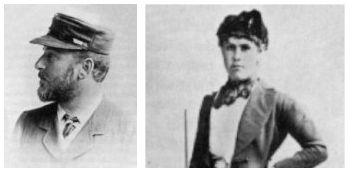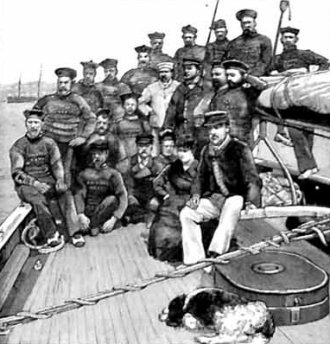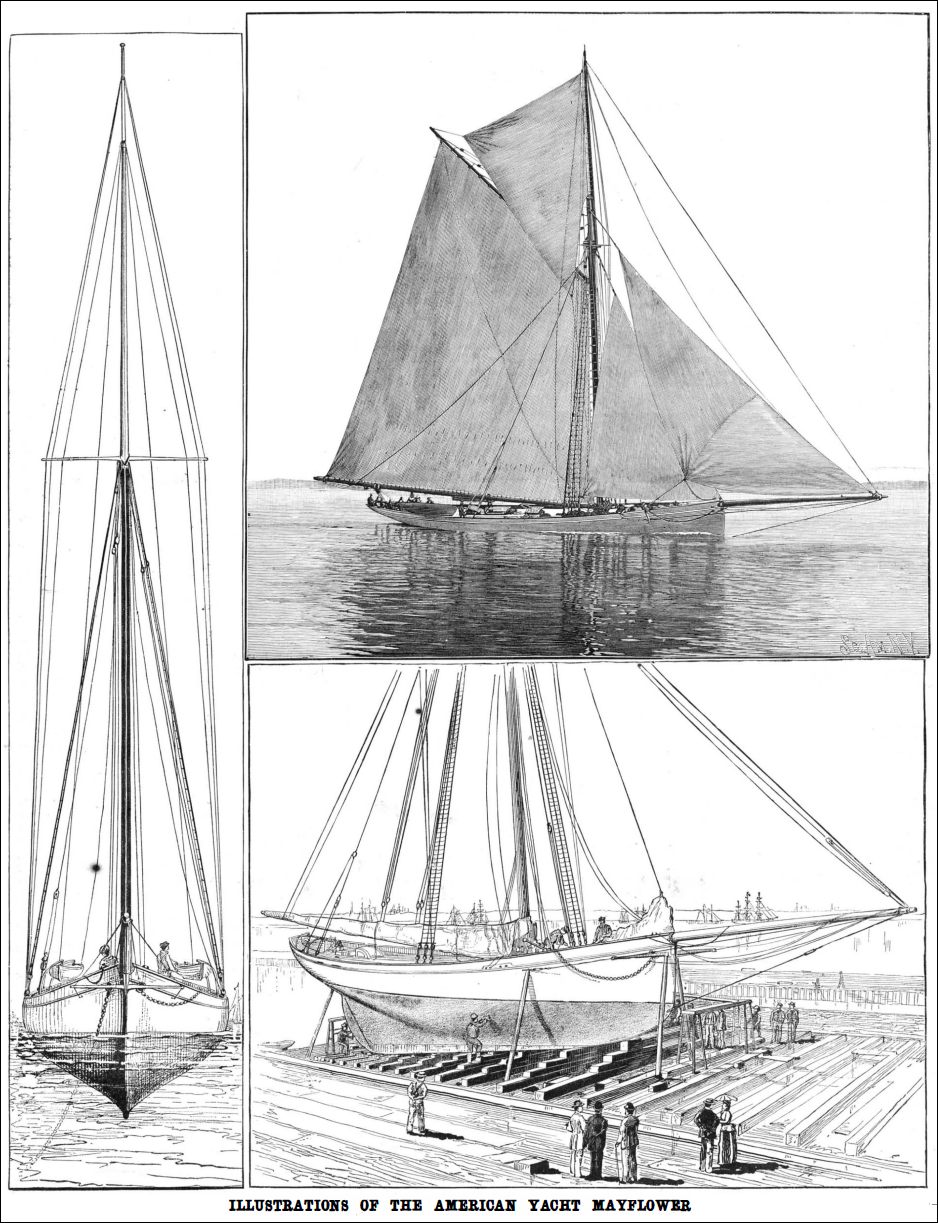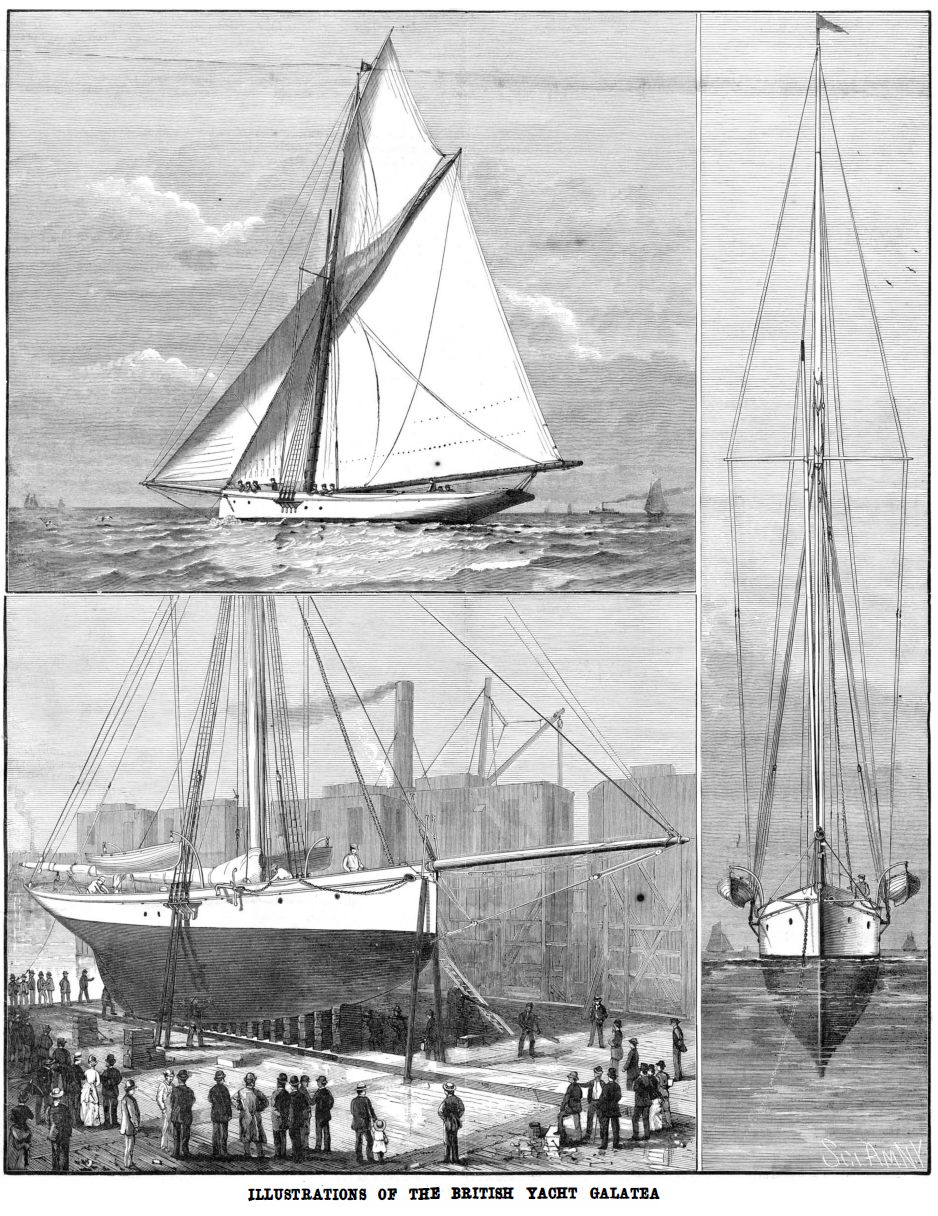Yves GARY Hits: 5467
Category: 1886 : CHALLENGE N°6
 A strange couple defied the N.Y.Y.C.
A strange couple defied the N.Y.Y.C.At the conclusion of the races of Puritan and Genesta, the New York Yacht Club took up the challenge of Lieut. William Henn of the Galatea, and at a meeting held October 22d, 1885, definitely accepted it, fixing the races for the following year. The conditions arranged for the races were practically the same as those in the 1885 series.
 If the Puritan-Genesta match had been a satisfactory one, and relations with Sir Richard Sutton pleasant, the race the following year was productive of just as good feeling; and these two matches did much to reestablish the harmony in international yachting affairs that the Ashbury incident and the Atalanta-Mischief race had broken.
If the Puritan-Genesta match had been a satisfactory one, and relations with Sir Richard Sutton pleasant, the race the following year was productive of just as good feeling; and these two matches did much to reestablish the harmony in international yachting affairs that the Ashbury incident and the Atalanta-Mischief race had broken.
After Genesta’s return to England the challenge on behalf of Galatea, which was withdrawn in 1885, was renewed by the Royal Northern Yacht Club of Great Britain, and accepted by the New York Yacht Club, suitable terms for a series of three races to be held in September, 1886, being easily agreed to. They were very much the same as those of the Puritan-Genesta match with boats likenesses drawn by the same architects.
But there is something unusually for this period: Lieut. William Henn is accompanied by his wife. Mrs. William Henn behaved as the perfect hostess on land or at sea. And any guest realised it at once when he came down inside Galatea, arriving in a luxurious saloon, furnished tastefully, draped by rich hangings and leopard-skin rugs, decorated with potted plants and precious objects. And to keep Mrs. Henn, the only woman on board, company, there were dogs and even a monkey, Peggy, the mascot who reacted to the slightest nautical maneuver aboard.


The competitors are illustrated both under sail and as they lay in the dry docks. To show more accurately the general model, the bilge blocks have been omitted, the latter views thus exposing the whole side. They are nearly of the same length, the Mayflower being two feet the shorter. In breadth and depth they differ widely; the Mayflower is much wider and shallower. Being wider, she carries more sail than the Galatea, and is handicapped, having to allow the Galatea 38 seconds over the inside course.
In the Galatea's model will be recognized the convex lines of the conventional cutter. Her sheer is quite pronounced, an end elevation of the hull showing a sharp rise in the bow that is missing in the Mayflower.
In the comparative side views of the two yachts as they lay in the dry docks, further differences will be noticed. The Galatea has a strongly rocking or curved keel. This is an important factor in her turning when tacking. In conjunction with her high momentum, due to her heavy ballasting, it enables her to go about very rapidly, the rudder not having time to check her speed. She is reported to have shown herself eight seconds quicker in stays than the Mayflower. Minor features in the rigging of the two vessels are also to be noticed in the different views. The Galatea's mast-head spreaders are so wide that they actually cause the topmast shrouds to overhang the hull, being wider than the hull itself. The use of a block and fall on the Galatea's bobstay, necessary with a shifting bowsprit, seems clumsy. Her bowsprit is considerably shorter in proportion to her length than is that of the American vessel. In both vessels, however, the bowsprit is far longer than in American yachts of thirty or forty years ago. In those days, a mast far back and short bowsprit was the rule. This feature is shown very strikingly in old pictures of the Black Maria, the first of our largest size racing sloops.
In the Mayflower, it will be noticed that her bilge is but slightly hollow, very little more than is that of her competitor. Accepting the sloop and cutter subdivisions as of any moment, her model, especially in this feature, indicates an approach of the American sloop to the English cutter. The theory has long held, and has been justified in practice. that a deep vessel was better in a seaway than a shallow one. There is no question that for rough weather, the old American shallow draught racing boats were defective. The foundering in the Gulf Stream of the Black Maria was a sad proof of this. But having overcome this wrong tendency, the point has been to stop when sufficient depth was reached. There is every probability that this has been done in the Mayflower. A broader vessel plunges less, and having a higher center of gravity rolls less, and careens less under sail, than does a narrow one. In these important respects, as affecting comfort, she is the superior. If it can be shown that this width is not inconsistent with speed, it may be considered that one valuable result has been attained.
The Genesta and Puritan, who competed last year for the international trophy, were somewhat smaller than the present competitors, but were large enough to represent the largest type of single-masted vessels.
The general result of recent yachting trials has developed the fact that greater speed is to be looked for from the single-masted vessel than from the schooner. This is, to an extent, unfortunate, as the schooner is far the more practical type. In our river and sound commerce for the last few years, nothing is more striking than the disappearance of sloops and increase in number of schooners. In old times, sloops have been engaged in ocean traffic to a certain extent, but now that rig is being abandoned except for the smallest class of vessel.
We give the table of dimensions of both vessels below. The interesting features are the relative displacement and lead ballast carried. The Galatea, it will be seen, is really 50 per cent larger than the Mayflower, and carries nearly twice as much ballast. Yet by the generous N. Y. Y. C. rules she receives a few seconds time allowance from the Mayflower. The exorbitant amount of outside lead ballast and large displacement certainly tend to make her more nearly a racing machine than is her competitor.
The Galatea is built of steel, and was modeled by Mr. J. Beavor-Webb. a native of Kinsale, County Cork, Ireland. The Mayflower is of wood, and was modeled by Mr. Edward Burgess, of Boston, Mass.

